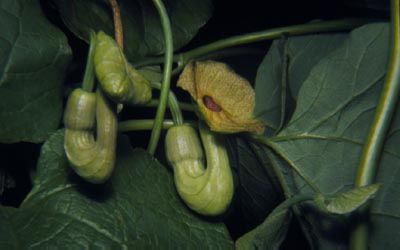Family: Aristolochiaceae

Photo © by Brooklyn Botanic Garden
Taken by G. A. Kalmbacher.
By Kerry Barringer
Not peer reviewed
Last Modified 04/29/2013
List of Aristolochiaceae Genera
References to Aristolochiaceae
- Angelo, R.; Boufford, D. E. 2010. Atlas of the flora of New England: Magnoliidae and Hamamelidae. Rhodora 112: 244-326.
- Baskin, J. M.; Baskin, C. C. 1986. Seed germination ecophysiology of the woodland herb Asarum canadense. Amer. Midl. Naturalist 116: 132-139.
- Cain, M. L. et.al. 1998. Seed dispersal and the Holocene migration of woodland herbs. Ecol. Monogr. 68: 325-347.
- Cain, M. L.; Damman, H. 1997. Clonal growth and ramet performance in the the woodland herb, Asarum canadense. J. Ecol. 85: 883-897.
- Cody, W. J. 1982. A comparison of the northern limits of distribution of some vascular plant species found in southern Ontario. Naturaliste Canad. 109: 63-90.
- Damman, H.; Cain, M. L. 1998. Population growth and viability analyses of the clonal woodland herb, Asarum canadense. J. Ecol. 86: 13-26.
- Flora of North America Editorial Committee. 1997. Flora of North America, Volume 3. Magnoliophyta: Magnoliidae and Hamamelidae. Oxford University Press, New York. , 590 pages.
- Gonzalez, F.; Rudall, P. J.; Furness, C. A. 2001. Microsporogenesis and systematics of Aristolochiaceae. Bot. J. Linn. Soc. 137: 221-242.
- Guedes, M. 1968. The vegetative leaf and the perianth of some Aristolochias. Flora 158: 167-79.
- Haber, H. 1960. Zur Abgrenzung der Gattung Aristolochia L. Mitt. Bot. Staatssamml. Munchen 3: 531-53.
- Handel, S. N.; Fisch, S. B.; Schatz, G. E. 1981. Ants disperse a majority of herbs in a mesic forest community in New York State. J. Torrey Bot. Soc. 108: 430-437.
- Huber, H. 1985. Seed characters and arrangement of Aristolochiaceae. Bot. Jahrb. Syst. 107: 277-320. (In German; English summary)
- Huber, H. 1993. Aristolochiaceae. In: The families and genera of the flowering plants. Dicotyledons. Vol. 2. Springer-Verlag, Berlin. , 129-37 pages.
- Hussey, J. S. 1974. Some useful plants of early New England. Econ. Bot. 28(3): 311-37.
- Kelly, L. M. 2001. Taxonomy of Asarum section Asarum (Aristolochiaceae). Syst. Bot. 26: 17-53.
- Kelly, L. M. 1997. A cladistic analysis of Asarum (Aristolochiaceae) and implications for the evolution of herkogamy. Amer. J. Bot. 84: 1752-1765.
- Kelly, L. M.; Gonzalez, F. 2003. Phylogenetic relationships in Aristolochiaceae. Syst. Bot. 28: 236-249.
- Leins, P.; Erbar, C. 1985. Contribution to floral development in Aristolochiaceae, a link to the Monocotyledons. Bot. Jahrb. Syst. 107: 343-68. (In German; English summary)
- Long Island Botanical Society Flora Committee. 1996. Preliminary atlas of the Magnoldiideae on Long Island, N.Y. Part 1. Long Island Botanical Society Newsletter 6(6): 41-4.
- Lorch, J. 1959. The perianth of Aristolochia, a new interpretation. Evolution 13: 415-6.
- Martin, T. 1983. Aristolochia. Amer. Horticulturist 62(2): 4-6.
- Mitchell, R. S.; Beal, E. D. (eds.) (1979): 1979. Magnoliaceae through Ceratophyllaceae of New York State. Vol. NY State Museum Bull. 435. Vol. Contributions to a Flora of New York State II.. Univ. of the state of NY, Albany, NY.
- Muir, A. M. 1995. The cost of reproduction to the clonal herb Asarum canadense (wild ginger). Canad. J. Bot. 73: 1683-1686.
- Ohi-Toma, T. et.al. 2006. Molecular phylogeny of Aristolochia sensu lato (Aristolochiaceae) based on sequences of rbcL, matK, and phyA genes, with special reference to differentiation of chromosome numbers. Syst. Bot. 31: 481-492.
- Pfeifer, H. W. 1962. The status of the name, Aristolochia durior Hill. Baileya 10: 4-7.
- Pfeifer, H. W. 1966. Revision of the North and Central American hexandrous species of Aristolochia (Aristolochiaceae). Ann. Missouri Bot. Gard. 53: 115-96.
- Pfeifer, H. W. 1970. A taxonomic revision of the Pentandrous species of Aristolochia.
- Pfluge Gregory, M. 1956. A phyletic rearrangement in the Aristolochiaceae. Amer. J. Bot. 43: 110-22.
- Robinson, B. L. 1908. Notes on the vascular plants of the northeastern United States. Rhodora 10: 29-35.
- Ruhren, S.; Handel, S. N. 2003. Herbivory constrains survival, reproduction and mutualisms when restoring nine temperate forest herbs. J. Torrey Bot. Soc. 130: 34-42.
- Schmidt, O. C. 1935. Aristolochiaceae. In: Natur. Pflanzenfam. II{.. Vol. 166. , 202-42 pages.
- Smith, B. H. et.al. 1989. Frequency-dependent seed dispersal by ants of two deciduous forest herbs. Ecology 70: 1645-1648.
- Solereder, H. 1889. Beitrõge zur vergleichenden Anatomie der Aristolochiaceen. Bot. Jahrb. Syst. 10: 410-524. (In German)
- Soltis, D. E. 1984. Karyotypes of species of Asarum and Hexastylis (Aristolochiaceae). Syst. Bot. 9: 490-493.
- Thorne, R. F. 1974. A phylogenetic classification of the Annoniflorae. Aliso 8: 147-209.
- Tippo, O. 1938. Comparative anatomy of the Moraceae and their presumed allies. Bot. Gaz. 100: 1-99.